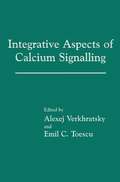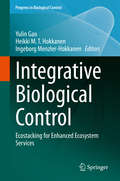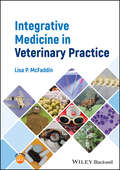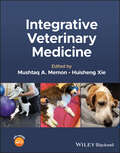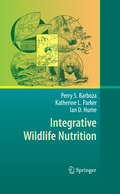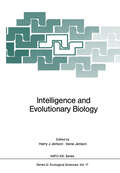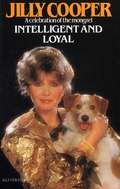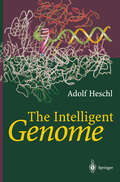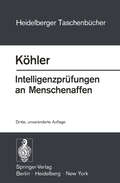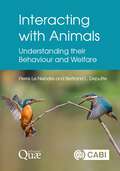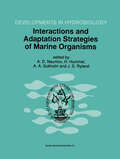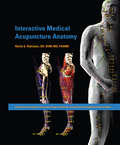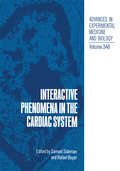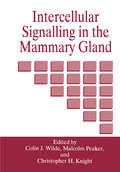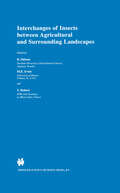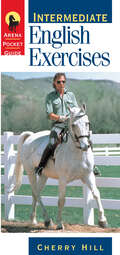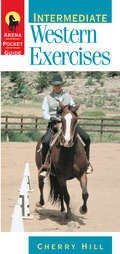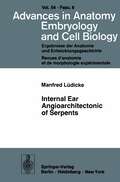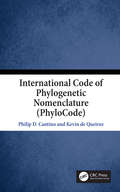- Table View
- List View
Integration of Insect-Resistant Genetically Modified Crops within IPM Programs (Progress in Biological Control #5)
by Jörg Romeis George Kennedy Anthony M. SheltonInsect pests remain one of the main constraints to food and fiber production worldwide despite farmers deploying a range of techniques to protect their crops. Modern pest control is guided by the principles of integrated pest management (IPM) with pest resistant germplasm being an important part of the foundation. Since 1996, when the first genetically modified (GM) insect-resistant maize variety was commercialized in the USA, the area planted to insect-resistant GM varieties has grown dramatically, representing the fastest adoption rate of any agricultural technology in human history. The goal of our book is to provide an overview on the role insect-resistant GM plants play in different crop systems worldwide. We hope that the book will contribute to a more rational debate about the role GM crops can play in IPM for food and fiber production.
Integration of Pharmaceutical Discovery and Development: Case Histories (Pharmaceutical Biotechnology #11)
by Ronald T. Borchardt Roger M. Freidinger Tomi K. Sawyer Philip L. SmithIn the late 1980s, it became painfully evident to the pharmaceutical industry that the old paradigm of drug discovery, which involved highly segmented drug - sign and development activities, would not produce an acceptable success rate in the future. Therefore, in the early 1990s a paradigm shift occurred in which drug design and development activities became more highly integrated. This new str- egy required medicinal chemists to design drug candidates with structural f- tures that optimized pharmacological (e. g. , high affinity and specificity for the target receptor), pharmaceutical (e. g. , solubility and chemical stability), bioph- maceutical (e. g. , cell membrane permeability), and metabolic/pharmacokinetic (e. g. , metabolic stability, clearance, and protein binding) properties. Successful implementation of this strategy requires a multidisciplinary team effort, incl- ing scientists from drug design (e. g. , medicinal chemists, cell biologists, en- mologists, pharmacologists) and drug development (e. g. , analytical chemists, pharmaceutical scientists, physiologists, and molecular biologists representing the disciplines of pharmaceutics, biopharmaceutics, and pharmacokinetics/drug metabolism). With this new, highly integrated approach to drug design now widely utilized by the pharmaceutical industry, the editors of this book have provided the sci- tific community with case histories to illustrate the nature of the interdisciplinary interactions necessary to successfully implement this new approach to drug d- covery. In the first chapter, Ralph Hirschmann provides a historical perspective of why this paradigm shift in drug discovery has occurred.
Integrative Aspects of Calcium Signalling
by Alexej Verkhratsky Emil C. ToescuHere is the first effort in a single volume to cover all of the integrative functions of calcium signalling - how changes in intracellular calcium coordinate a variety of coherent cellular responses. Written by a team of internationally established researchers, Integrative Aspects of Calcium Signalling provides the latest experimental data and concepts, bringing together a detailed analysis of the events, processes, and functions regulated by calcium signalling. A unique resource for professionals and students of physiology, biophysics, neurobiology, biochemistry, and all related fields.
Integrative Biological Control: Ecostacking for Enhanced Ecosystem Services (Progress in Biological Control #20)
by Yulin Gao Heikki M. T. Hokkanen Ingeborg Menzler-HokkanenThis book is the first to integrate biological control into a conceptual framework – ecostacking - uniting all aspects of biological control and ecosystem services. In 2018 the "First International Congress of Biological Control" was organised and held in Beijing, China. The chapters highlight some of the achievements presented at the congress, worldwide. Of particular significance are the numerous contributions by Chinese researchers illustrating the remarkable progress made on developing and adopting multiple biological control strategies over vast agricultural areas, largely replacing chemical pesticides for sustainable agricultural and horticultural production. In many parts of the world including Europe, fragmented research based on short-term funding has been unable to answer to the needs to develop sustainable long-term solutions to crop protection, while colleagues in China have been successful in implementing programs that exemplify the power of the ecostacking approach. Key contributions by European and US specialists combined with the expertise and experiences by the Chinese contributors comprise the building blocks for the integration of biological control approaches into the overall frame of ecostacking. This book will lead the way to a broader, integrated adoption of biological control techniques in sustainable pest, disease and weed management supporting also the functioning of other key ecosystem services.Chapter 2 of this book isavailable openaccess under a CC BY 4.0 license at link.springer.com
Integrative Functions in the Mammalian Auditory Pathway (Springer Handbook of Auditory Research #15)
by Donata OertelA summary of how the electrical signals used to represent sounds are encoded and interpreted through the integrated roles of various nuclei. This volume builds on the information about the anatomy and physiology of the auditory pathway found in volumes 1 and 2 of the SHAR series. While the first two volumes describe the structure and function of auditory pathways, this one explains how these pathways lead to an animal's ability to localize and interpret sounds.
Integrative Medicine in Veterinary Practice
by Lisa P. McFaddinIntegrative Medicine in Veterinary Practice Enables the entire veterinary team to seamlessly incorporate integrative medicine into everyday practice Integrative Medicine in Veterinary Practice is a unique resource designed to introduce the basic concepts of ten different integrative modalities to all members of the hospital team to establish a baseline of knowledge: explaining how patients will benefit from their use, discussing return on investment, informing veterinarians of available courses and suggested reading materials, walking managers through staff training, and providing client education materials. Supplemental web-based documents and presentations increase the ease with which staff are trained and clients are educated. Integrative medicine is not an all-or-nothing concept. This umbrella term encompasses a wide spectrum of treatment modalities. Therapies can be used individually or in combination, as part of a multimodal approach, and applied easily to every patient or used in select cases. Sample topics covered in Integrative Medicine in Veterinary Practice include: Photobiomodulation, covering light, laser specifics, mechanisms of action, supplies and equipment, and techniques Veterinary Spinal Manipulation Therapy (VSMT), covering pain in veterinary patients, mechanisms of action, adjustment vs. manipulation vs. mobilization, techniques, and post-adjustment recommendations Acupuncture, covering acupuncture point selection using traditional Chinese veterinary medicine (TCVM) and Western medicine techniques, mechanisms of action, safety, and practical applications. Chinese Herbal Medicine (CHM), covering TCVM fundamentals as it applies to herbal classification and selection, herb production, safety, and formulation, and CHM applications. Integrative Medicine in Veterinary Practice is a valuable resource for all veterinary hospital team members, from customer service representatives to veterinary assistants/technicians, practice managers, and veterinarians. The text is also helpful to veterinary students interested in integrative medicine, or those taking introductory integrative medicine courses.
Integrative Medicine in Veterinary Practice
by Lisa P. McFaddinIntegrative Medicine in Veterinary Practice Enables the entire veterinary team to seamlessly incorporate integrative medicine into everyday practice Integrative Medicine in Veterinary Practice is a unique resource designed to introduce the basic concepts of ten different integrative modalities to all members of the hospital team to establish a baseline of knowledge: explaining how patients will benefit from their use, discussing return on investment, informing veterinarians of available courses and suggested reading materials, walking managers through staff training, and providing client education materials. Supplemental web-based documents and presentations increase the ease with which staff are trained and clients are educated. Integrative medicine is not an all-or-nothing concept. This umbrella term encompasses a wide spectrum of treatment modalities. Therapies can be used individually or in combination, as part of a multimodal approach, and applied easily to every patient or used in select cases. Sample topics covered in Integrative Medicine in Veterinary Practice include: Photobiomodulation, covering light, laser specifics, mechanisms of action, supplies and equipment, and techniques Veterinary Spinal Manipulation Therapy (VSMT), covering pain in veterinary patients, mechanisms of action, adjustment vs. manipulation vs. mobilization, techniques, and post-adjustment recommendations Acupuncture, covering acupuncture point selection using traditional Chinese veterinary medicine (TCVM) and Western medicine techniques, mechanisms of action, safety, and practical applications. Chinese Herbal Medicine (CHM), covering TCVM fundamentals as it applies to herbal classification and selection, herb production, safety, and formulation, and CHM applications. Integrative Medicine in Veterinary Practice is a valuable resource for all veterinary hospital team members, from customer service representatives to veterinary assistants/technicians, practice managers, and veterinarians. The text is also helpful to veterinary students interested in integrative medicine, or those taking introductory integrative medicine courses.
Integrative Veterinary Medicine
by Mushtaq A. Memon Huisheng XieIntegrative Veterinary Medicine Practical guide integrating holistic modalities into Western veterinary practice to help with patient treatment Integrative Veterinary Medicine provides a clinically oriented, evidence-based guide to integrating complementary and conventional therapies into veterinary practice. Covering acupuncture, manual therapies, botanical and herbal medicine, integrative nutrition, and physical rehabilitation, the book draws information on these modalities together into a single resource. Rooted in evidence-based medicine, it demonstrates how to use these modalities in veterinary practice. The book begins by discussing the basic concepts of integrative veterinary medicine, then examines each modality in detail. A companion website offers video clips showing acupuncture techniques. In Integrative Veterinary Medicine, readers can expect to find detailed information on topics such as: Anatomy and physiology of acupuncture with relation to soft tissue and neurologic concepts, and traditional Chinese theory of acupuncture (Yin and Yang, Five Element Theory, and The Meridians) Veterinary manipulative therapy (neurology, biomechanics, and available evidence), and massage therapy and myofascial principles Origins and major systems of herbal therapy with selected evidence-based interventions and adverse events, herb-drug interactions, supplement evaluation, and regulation Trends in nutrition, such as raw diets, home-prepared diets, grain-free diets, owner perception, and current marketing Covering common modalities across all species in one volume, Integrative Veterinary Medicine is an essential reference for any veterinary practitioner wishing to use integrative techniques in their practices, as well as veterinary students, academics, and researchers involved in programs of study related to integrative veterinary medicine.
Integrative Veterinary Medicine
by Mushtaq A. Memon Huisheng XieIntegrative Veterinary Medicine Practical guide integrating holistic modalities into Western veterinary practice to help with patient treatment Integrative Veterinary Medicine provides a clinically oriented, evidence-based guide to integrating complementary and conventional therapies into veterinary practice. Covering acupuncture, manual therapies, botanical and herbal medicine, integrative nutrition, and physical rehabilitation, the book draws information on these modalities together into a single resource. Rooted in evidence-based medicine, it demonstrates how to use these modalities in veterinary practice. The book begins by discussing the basic concepts of integrative veterinary medicine, then examines each modality in detail. A companion website offers video clips showing acupuncture techniques. In Integrative Veterinary Medicine, readers can expect to find detailed information on topics such as: Anatomy and physiology of acupuncture with relation to soft tissue and neurologic concepts, and traditional Chinese theory of acupuncture (Yin and Yang, Five Element Theory, and The Meridians) Veterinary manipulative therapy (neurology, biomechanics, and available evidence), and massage therapy and myofascial principles Origins and major systems of herbal therapy with selected evidence-based interventions and adverse events, herb-drug interactions, supplement evaluation, and regulation Trends in nutrition, such as raw diets, home-prepared diets, grain-free diets, owner perception, and current marketing Covering common modalities across all species in one volume, Integrative Veterinary Medicine is an essential reference for any veterinary practitioner wishing to use integrative techniques in their practices, as well as veterinary students, academics, and researchers involved in programs of study related to integrative veterinary medicine.
Integrative Wildlife Nutrition
by Perry S. Barboza Katherine L. Parker Ian D. HumeNutrition spans a wide range of mechanisms from acquisition of food to digestion, absorption and retention of energy substrates, water and other nutrients. Nutritional principles have been applied to improving individual health, athletic performance and longevity of humans and of their companion animals, and to maximizing agricultural efficiency by manipulating reproduction or growth of tissues such as muscle, hair or milk in livestock. Comparative nutrition borrows from these tra- tional approaches by applying similar techniques to studies of ecology and physiology of wildlife. Comparative approaches to nutrition integrate several levels of organization because the acquisition and flow of energy and nutrients connect individuals to populations, populations to communities, and communities to ecosystems. Integrative Wildlife Nutrition connects behavioral, morphological and biochemical traits of animals to the life history of species and thus the dynamics of populations. An integrated approach to nutrition provides a practical framework for understanding the interactions between food resources and wildlife popu- tions and for managing the harvest of abundant species and the conservation of threatened populations. This book is for students and professionals in animal physiology and ecology, conservation biology and wildlife management. It is based on our lectures, dem- strations and practical classes taught in the USA, Canada and Australia over the last three decades. Instructors can use Integrative Wildlife Nutrition as a text in wildlife and conservation biology programs, and as a reference source for related courses in wildlife ecology.
Intelligence and Evolutionary Biology (Nato ASI Subseries G: #17)
by Harry J. Jerison Irene JerisonIn evolutionary biology, "intelligence" must be defined in terms of traits that are subject to the major forces of organic evolution. Accordingly, this volume is concerned with the substantive questions that are relevant to the evolutionary problem. Comparisons of learning abilities are highlighted by a detailed report on similarities between honeybees and higher vertebrates. Several chapters are concerned with the evolution of cerebral lateralization and the control of language, and recent analyses of the evolution of encephalization and neocorticalization, including a review of effects of domestication on brain size are presented. The relationship between brain size and intelligence is debated vigorously. Most unusual, however, is the persistent concern with analytic and philosophical issues that arise in the study of this topic, from the applications of new developments on artificial intelligence as a source of cognitive theory, to the recognition of the evolutionary process itself as a theory of knowledge in "evolutionary epistemology".
Intelligent and Loyal
by Jilly Cooper ObeA celebration of the mongrel.The mongrel occupies a special place in our hearts and homes. Jilly Cooper collected stories from hundreds of owners to write this engaging and affectionate tribute. She presents a delightful account of the lives and natures of a vast assortment of dogs of doubtful parentage: a fascinating, moving and entertaining chronicle of their exploits and accomplishments, their bravery, devotion and wisdom. Jilly's special method of classification enables you to tell instantly if your pet is a Woolly Whitejaw, a Borderline Collie, a Bertrand Russell or a Lancashire Hot Pet. At last, our mongrels have achieved the recognition they have so long deserved...
The Intelligent Genome: On the Origin of the Human Mind by Mutation and Selection
by Adolf HeschlDo our genes determine our behavior? Do humans occupy a unique position in evolution? To clarify these provoking questions, the author takes the reader on an ambitious and entertaining journey through a variety of scientific disciplines. In doing so, he creates an image of human evolution that argues that our entire individual knowledge is determined - to the smallest detail - by phylogeny. A provoking and controversial analysis of the theory of our inability to learn something new and of the extent to which our behavior is determined by our genes.
Intelligenzprüfungen an Menschenaffen: Mit einem Anhang zur Psychologie des Schimpansen (Heidelberger Taschenbücher #134)
by W. KöhlerInteracting with Animals: Understanding their Behaviour and Welfare
by Dr Pierre Le Neindre Dr Bertrand DeputteAnimal behaviour and, as a result, animal welfare are increasingly complex areas of study, with the diversity of the animal kingdom and new research findings ensuring there is no one, easy answer. Instead, we need to take a holistic approach, combining scientific principles with both philosophical and ethical considerations to develop all-inclusive policies and legislation that decide how society should interact with domestic, farm and native animals. With a focus on domestic animals, while also referring to wild species to reinforce the arguments, this book: · promotes direct observation for those who claim to be interested in animals, their behaviour, and their welfare. · considers the concept of consciousness, how it can be assessed, and how it relates to suffering and animal welfare more widely. · emphasizes the need to understand better how animals behave both with humans and outside of human influence, considering the diversity of behaviour and sensorial capacities across species. · includes author knowledge and expertise across a wide range of animal species, from primates to farm animals, and across animal living situations from intensive to free ranging. We are far from having all the answers, so this book also raises questions that require further research and focus, such as the way animals are likely to act based on their recent and whole-of-life experiences. Still, this review of the topic, an updated translation of the French language work Vivre parmi les animaux, mieux les comprendre, is an invaluable resource for everyone with an interest in animal behaviour and welfare.
Interactions and Adaptation Strategies of Marine Organisms: Proceedings of the 31st European Marine Biology Symposium, held in St. Petersburg, Russia, 9–13 September 1996 (Developments in Hydrobiology #121)
by J. S. Ryland A. A. Sukhotin H. Hummel A. D. NaumovThis volume provides a refereed selection of the proceedings of the 31st European Marine Biology Symposium, held in St. Petersburg, Russia, in September 1996. State-of-the-art reviews and studies on adaptational processes in marine organisms such as adaptations to fluctuations in salinity, temperature, oxygen and pollutants which are reflected in different types of ecophysiological responses and interactions of marine organisms, including predation, parasitism, intraspecific competition and epibiosys were presented at the symposium proceedings. Research from both eastern and western Europe contributed to this project and during the symposium differences in scientific approaches and views between these two groups became apparent. The contents of this volume reflect these differences. Researchers and students in marine biology as well as those involved in coastal management and environmental studies will find this volume of interest.
Interactive Medical Acupuncture Anatomy
by Narda G. RobinsonThis presentation uses anatomically precise, computer-generated reconstructed images of the human body for three-dimensional presentation of acupuncture points and channels. The CD component is fully interactive and allows the user to see through tissue layers, remove tissue layers, and rotate structures so that specific acupuncture points can be v
Interactive Phenomena in the Cardiac System (Advances in Experimental Medicine and Biology #346)
by S. Sideman Rafael BeyerThe cardiac system represents one of the most exciting challenges to human ingenuity. Critical to our survival, it consists of a tantalizing array of interacting phenomena, from ionic transport, membrane channels and receptors through cellular metabolism, energy production to fiber mechanics, microcirculation, electrical activation to the global, clinically observed, function, which is measured by pressure, volume, coronary flow, heart rate, shape changes and responds to imposed loads and pharmaceutical challenges. It is a complex interdisciplinary system requiring the joint efforts of the life sciences, the exact sciences, engineering and technology to understand and control the pathologies involved. The Henry Goldberg Workshops were set up to address these multivariable, multidisciplinary challenges. Briefly, our goals are: To encourage international cooperation and foster interdisciplinary interaction between scientists from the different areas of cardiology; to relate microscale cellular phenomena to the global, clinically manifested cardiac function; to relate conceptual modeling and quantitative analysis to experimental and clinical data; to gain an integrated view of the various interacting parameters, identify missing links, catalyze new questions, and lead to better understanding of the cardiac system. The outstanding success of past workshops has encouraged their continuation. The first Henry Goldberg Workshop, held in Haifa in 1984, introduced the concept of interaction between mechanics, electrical activation, perfusion and metabolism, emphasizing imaging in the clinical environment. The second Workshop, in 1985, discussed the same parameters with a slant towards the control aspects.
Intercellular Signalling in the Mammary Gland: Proceedings Of The 1994 Hannah Symposium Held In Ayr, Scotland, April 13-15, 1994
by Christopher H. Knight MalcolmPeaker Colin J. WildeAll being done, we went to Mrs Shipmans, who is a great butter-woman; and I did see there the most of milke and cream, and the cleanest, that I ever saw in my life (29 May 1661). Among others, Sir Wm. Petty did tell me that in good earnest, he hath in his will left such parts of his estate to him that could invent such and such things -as among others, that could discover truly the way of milk coming into the breasts of a woman ... (22 March 1665). My wife tells me that she hears that my poor aunt James hath had her breast cut off here in tow- her breast having long been out of order (5 May 1665). From the Diary of Samuel Pepys, published as The Shorter Pepys (edited by R. Latham), Penguin Books (1987) The long-standing ultimate importance of research on the mammary gland is illustrated by the importance attached to cows' milk for human consumption, to human lactation and to breast cancer by Samuel Pepys and his contemporaries in the middle of the 17th century. Research has tended to develop in isolation in these three areas of continuing contemporary importance largely because in most countries, the underlying science of agricultural productivity is funded separately from the underlying science of human health and welfare.
Interchanges of Insects between Agricultural and Surrounding Landscapes
by B. S. Ekbom Michael E. Irwin Y. RobertThe chapters in this book were developed from some of the lectures presented at a sym posium at the XX International Congress of Entomology held in Florence, Italy in August 1996. The purpose of the symposium was to discuss the impact of evolving modern agricultural landscapes on the insect species, of both economic and ecological importance, that utilize that habitat. Agricultural policy, to some extent, influences the choices that farmers make and thereby the shape of the agricultural landscape. In order to move toward more sustainable agro ecosystems future policy makers will have to consider the history of land use, consumer demands for both environmentally sound and affordable products, and the conservation of biological diversity. I would hope the information contained in this book will help stimulate discussion about the consequences of policy decisions on our agricultural landscapes and their insect inhabitants. I thank all the speakers from the symposium and in particular those that have been able to contribute chapters to this book. There have been many delays, most due to circumstances beyond anyone's control. I would like to express my appreciation to Gloria Verhey and Patrick Dumont for taking care of the book in these final months. CHAPTER I INTERCHANGES OF INSECTS BETWEEN AGRICULTURAL AND SURROUNDING LANDSCAPES BARBARA EKBOM Department of Entomology, Swedish University of Agricultural Sciences, Uppsala, Sweden 1.
Intermediate English Exercises
by Cherry HillWith this pocket-sized guide in hand, you'll find it easy to develop and perfect your English riding skills. Cherry Hill's exercises will help you learn to hone balance and precise use of aids, improve bending, polish transitions, develop lateral work, and begin collection.
Intermediate Western Exercises
by Cherry HillTake your riding to the next level! Hone balance, tighten transitions, and begin collection as you develop your Western riding skills. In this equestrian workbook, veteran trainer Cherry Hill presents a series of focused exercises that include clearly stated goals, illustrated directions, arena maps, and appropriate safety concerns. With a pocket-sized trim perfect for easy reference in the saddle, this book is designed to help you improve your riding form and maximize the benefits of your training sessions.
Internal Ear Angioarchitectonic of Serpents (Advances in Anatomy, Embryology and Cell Biology #54/6)
by M. LüdickeInternational Code of Phylogenetic Nomenclature (PhyloCode): A Phylogenetic Code of Biological Nomenclature
by Kevin de Queiroz Philip D. CantinoThe PhyloCode is a set of principles, rules, and recommendations governing phylogenetic nomenclature, a system for naming taxa by explicit reference to phylogeny. In contrast, the current botanical, zoological, and bacteriological codes define taxa by reference to taxonomic ranks (e.g., family, genus) and types. This code will govern the names of clades; species names will still be governed by traditional codes. The PhyloCode is designed so that it can be used concurrently with the rank-based codes. It is not meant to replace existing names but to provide an alternative system for governing the application of both existing and newly proposed names. Key Features Provides clear regulations for naming clades Based on expressly phylogenetic principles Complements existing codes of nomenclature Eliminates the reliance on taxonomic ranks in favor of phylogenetic relationships Related Titles: Rieppel, O. Phylogenetic Systematics: Haeckel to Hennig (ISBN 978-1-4987-5488-0) de Queiroz, K., Cantino, P. D. and Gauthier, J. A. Phylonyms: A Companion to the PhyloCode (ISBN 978-1-138-33293-5).
International Code of Phylogenetic Nomenclature (PhyloCode): A Phylogenetic Code of Biological Nomenclature
by Kevin de Queiroz Philip D. CantinoThe PhyloCode is a set of principles, rules, and recommendations governing phylogenetic nomenclature, a system for naming taxa by explicit reference to phylogeny. In contrast, the current botanical, zoological, and bacteriological codes define taxa by reference to taxonomic ranks (e.g., family, genus) and types. This code will govern the names of clades; species names will still be governed by traditional codes. The PhyloCode is designed so that it can be used concurrently with the rank-based codes. It is not meant to replace existing names but to provide an alternative system for governing the application of both existing and newly proposed names. Key Features Provides clear regulations for naming clades Based on expressly phylogenetic principles Complements existing codes of nomenclature Eliminates the reliance on taxonomic ranks in favor of phylogenetic relationships Related Titles: Rieppel, O. Phylogenetic Systematics: Haeckel to Hennig (ISBN 978-1-4987-5488-0) de Queiroz, K., Cantino, P. D. and Gauthier, J. A. Phylonyms: A Companion to the PhyloCode (ISBN 978-1-138-33293-5).


